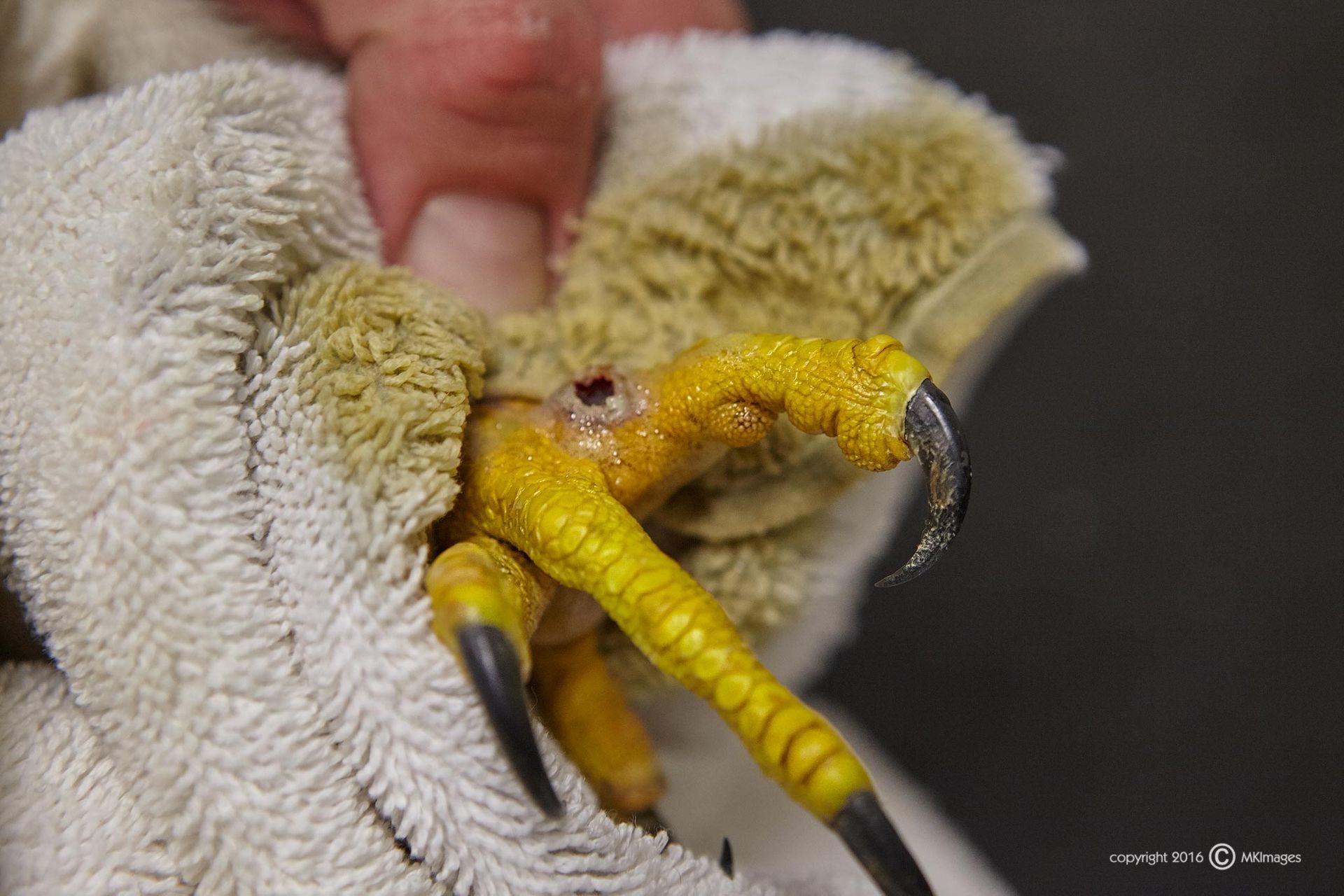THREATS AND
CONSERVATION
Rehabilitation cases highlighting the threats to
Australian raptors.
Photographer: Ange Anderson
vehicle collisions
Motor vehicle collisions are consistently the most common presentation for native animals coming into care in NSW, and the leading cause of injury for birds of prey throughout Australia, particularly for carrion-feeders like Wedge-tailed Eagles, who are often seen feeding on roadkill beside (and often on) major roads.
WARNING - GRAPHIC IMAGE BELOW
This Masked owl was hit by a police car who immediately contacted HGRC and then delivered the bird. The bird was lucky to suffer only a concussion (left), and recovered well after only a week of rehabilitation (right).
He was released back in his territory one week later with a happy police officer present.
Photographer: Mark Kelly
A Wedge-tailed eagle hit the windscreen of this Hilux, sustaining extensive trauma to the left wing. His initial stabilisation and early rehabilitation was with Mel Barsony of WIRES Northern Rivers, and when he was ready for a free-flight aviary he was transferred to HGRC.
After a lengthy period in care recovering from wing trauma and regaining pre-release fitness the bird was released.
Photographer: Mel Barsony
window collisions
When building collisions occur, it is generally with windows or other reflective surfaces. During the day, window collisions happen when a transparent pane obstructs a flight path, but suitable habitat or the sky can been seen through it; or when panes reflect landscape features that attract birds, such as vegetation, food sources, potential perches (e.g. building ledges), or the sky. Night collisions generally occur when artificial lights emitted from a window can disorientate birds, or give them the impression that they can fly through to the interior of the building.
There are currently no reliable estimates of bird mortality resulting from these collisions in Australia. However, between 365 and 988 million birds are estimated to be killed annually this way in the United States, and between 16 and 42 million birds in Canada. The British Trust for Ornithology estimates that building collisions kill about 30 million birds per year in the United Kingdom. In the United States, low-rise office and other commercial buildings, and stadiums are responsible for 56% of mortalities, 44% at residences, and less than 1% at high-rise buildings (skyscrapers).
This Collared sparrowhawk left an imprint - powder from its downy feathers - on the shed window that it hit. Sparrowhawks catch prey on the wing, either in low, fast flight or in short, surprise bursts, so this bird was likely hunting when it collided with this window.
Luckily the bird suffered only a mild concussion and was ready for release the following day, in the same area it was originally found.
Photographer: Charlie Carter
A Peregrine falcon was hunting prey and hit the living room window of a house so hard that it broke the window. The homeowner placed the falcon in a spare birdcage temporarily and contacted her local wildlife rescue group.
The bird had multiple impact wounds and numerous pieces of glass lodged in her body, particularly the feet. After successful treatment and rehabilitation she underwent pre-release fitness and was then released back where she was found, flying straight to a local dam, much to the horror of the ducks!
WInd turbines
Birds of prey are at particular risk around windfarms, because they use the same resources that turbines utilise – the thermals and updraughts - to gain height. This makes them particularly vulnerable to collisions with wind turbine blades, which can travel at speeds of up to 290km/hour. As the transition to renewable energy gains pace, more birds are likely to become victims. Research suggests that in South Africa more than a third of all birds killed by wind turbines are birds of prey; in these species which do not produce many offspring per year, even a small number of deaths can have an over-large impact on population size. Different strategies are being explored in attempts to reduce the fatalities related to windfarms, such as radar technology to shut down turbines when specified birds approach.
The Little eagle was declared a "vulnerable" species in the Australian Capital Territory in 2008, and is also listed as "vulnerable" in New South Wales. Regions of eastern Australia in which the Little eagle is found are also ideal for the placement of windfarms, leading to tragic injuries such as these.
This Little eagle was found deceased underneath a wind turbine with multiple severe injuries. The black areas of the wing seen here is extensive bruising associated with bone fractures. The . Massive with massive bruising and multiple injuries.
Photographer: Peg McDonald
In the spirit of reconciliation, Australian Raptor Care and Conservation Inc acknowledges the Traditional Custodians of country throughout Australia and their connections to land, sea and community. We pay our respect to their Elders past and present and extend that respect to all Aboriginal and Torres Strait Islander peoples today. We recognise and appreciate the traditional significance and cultural roles birds of prey play in the lives of our First Nations people.



